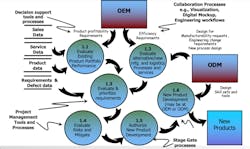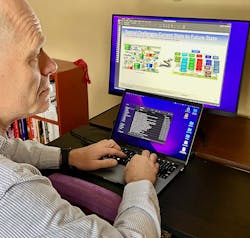The tools and techniques of digital transformation greatly simplify and speed up new product development. They are counterproductive and even senseless, however, if put to work supporting the “same-old, same-old” processes of product development, design engineering, manufacturing and service. The same is true for the processes used in every other business unit in the enterprise.
For project managers and enterprise leadership in digital transformation, the need for process modernization should be obvious. Digital transformation’s tools and techniques can greatly improve collaboration and innovation in new-product development, as just one example, but not until many existing processes are updated—or, as is often necessary, re-engineered. This is never simple.
Just as products are re-engineered to accommodate new capabilities, processes also must be re-engineered. Re-engineering is a proven way to address processes ill-suited to the trends and enablers of digital transformation; these can be large stumbling blocks for collaboration, productivity and even enterprise sustainability.
These views were spelled out in a recent virtual conference I participated in on process innovation and digital transformation (“PI-DX”) run by Marketkey Ltd., a London-based business-information company focused on refining data into intelligence, business insights and innovation.
The panel focused on what Marketkey labels “legacy technical debt.” The remedies discussed included process “modernization” and process “innovation,” but problems in some processes run deep. These can only be addressed by re-engineering the process, ideally while replacing obsolete legacy systems and upgrading the technical skills of the workforce.
Process re-engineering is tied to digital transformation at several levels wherein information is freed from pre-operative formats such as spreadsheets, CAD-generated drawings and e-mail attachments; many critical processes are rendered obsolete.
Digital transformation requires up-to-date systems, tools, techniques and solutions; they can be difficult to work with. Amid new realities of data and information, these challenges require skills updates, too.
Processes that until recently were expected to change little have been demolished by technology and tech-savvy new workers, choosier customers, ceaseless innovation and shorter product lifecycles. Consequently, many long-established practices in the handling of information in processes are headed for the dustbin of digital history.
Changing the Thinking
As goes information, so go the processes we use to search, use and manage it. Enterprises, business units and solution providers clearly see that their assumptions about many everyday processes have become questionable.
“The way we have been getting things done” no longer keeps up with the speed of innovation in today’s marketplaces. And it is product and process innovation that helps fend off competitors, hang on to demanding customers and shore up profit margins.
Viewed in this light, it is little wonder that processes are being impacted in every product and asset lifecycle. These impacts are most disruptive in determining new product requirements and throughout design, engineering, production, service, and all data handling and information gathering tasks.
Users and managers also struggle with fallout from legacy systems and tools and the processes that support them. A pair of all-too-common examples:
- Reworking newly manufactured products at the ends of assembly lines, delaying shipment and running up costs
- Iffy, on-the-fly workarounds that turn into repetitive do-loops producing nothing but frustration
Both are good places to launch process re-engineering and easily win user support.
Re-engineering any process starts with a deep dive to pinpoint where and why things go wrong. Once the problems and their causes are clearly identified, address them one by one. So a big part of process re-engineering is developing new capabilities to reconfigure the tasks and sub-tasks that make up the process. Once these new capabilities are chosen, test and verify them. Though tedious, testing and verifying must be done with care.
Processes usually generate predetermined outcomes that support decisions or feed additional processes. Poorly planned changes to a process, or even to just a few of its tasks, could blindside workers elsewhere in the business unit.
In the enterprise’s high-level business processes, the impacts of re-engineering run even deeper. These processes include concept to design, design to manufacturing, orders to cash and others that must not be overlooked.
A typical scenario for CIMdata clients takes shape while the processes are being re-engineered. After the process changes have been verified as viable, CIMdata continues to help the client while the re-engineered processes are put into use and, equally importantly, integrate the changes with other processes that are closely connected.
At this point, several crucial decisions must be made, and the synergy of outside expertise and knowledgeable staffers comes into force. These decisions focus on ensuring user buy-in as well as how best to gain the support of all those whose work is tied to the process(es) being re-engineered. Other key decisions cover lining up in-house technical resources and securing financial support.
Changing the Work Process
A big part of the value of process re-engineering lies in helping the workforce grasp the benefits in letting go of obsolete processes. If the workforce is to welcome change and embrace innovation, make sure that decisions about re-engineering are clearly communicated.
An alternative approach to these communications is budgetary—putting business issues first. This means linking anticipated re-engineering costs to projected revenue gains.
To help with building your case for re-engineering a process, here are a few realities that must not be overlooked:
- Processes are linked in countless ways, even without the bidirectional and end-to-end (E2E) connectivity essential for maximum efficiency
- Process changes occur fast and often, prompting users to modify their processes themselves
- Process changes at the business-unit level are triggered by innovation such as augmented/virtual reality and advanced analytics
- Process changes also impact users directly—artificial intelligence and machine learning, for example
- At the enterprise level, processes are disrupted by model-based engineering, system-of-systems thinking, predictive analytics and agile software development
As the skills of the workforce are upgraded and transformed, new and better ways will be found to connect people, data, technologies and tools. As these are implemented, process re-engineering will grow in value—and inevitability.
Perhaps the best approach to process re-engineering is to undertake it together with workforce transition and skills upgrades. None of these crucial initiatives can achieve its full potential without the others. Transitioning workforce skills while re-engineering their processes can go a long way assure the ultimate success of digital transformation and, in turn, help secure the sustainability and long-term competitiveness of the enterprise.
Tom Gill is CIMdata practice manager for PLM Enterprise Value & Integration. Prior to joining CIMdata in 2010, he was a PLM director in a Tier 1 U.S. automotive supplier. Before that he had roles in CAD programming, engineering system administration and mechanical engineering.
What Does Re-engineering a Process Really Mean?
Process re-engineering involves reviewing the existing operations, starting with the most badly broken processes to identify:
- Business objectives, clearly stated and understood
- Learning why, when and by whom the process was created
- Required process outputs
- Inputs that are still valid and verify with users
- Process steps to be added or dropped
- Outputs to be verified with users
- Process changes to be prototyped
- Changes to be validated
- Whether better tools are needed
- Changes in processes to be prototyped
- Processing changes to be validated
- Effectiveness of process connectivity
- Impacts of changes on connected and dependent processes
When undertaking change, they key ideas are:
- Validating processes being scaled up to production status
- Communicating all planned changes
- Establishing effective governance with a framework to manage organizational change
- Evaluating alternative tools, systems and technologies
- Evaluating lesser included sub-tasks
- Assembling, finalizing and verifying new processes, then running tests
- Implementing new processes—initially next to legacy processes
- Reverifying process transparency
- Establishing a help desk


